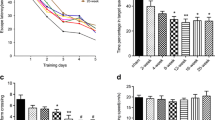Abstract
Chronic cerebral hypoperfusion (CCH) causes neurodegeneration which contributes to the cognitive impairment. This study utilized a modified rat model with CCH to investigate cerebral blood flow (CBF) and hippocampal metabolic changes. CBF was measured by laser Doppler flowmetry. Various metabolic ratios were evaluated from selective volumes of interest (VOI) in left hippocampal regions using in vivo proton magnetic resonance spectroscopy (1H-MRS). The ultrastructural changes with special respect to ribosomes in rat hippocampal CA1 neurons were studied by electron microscopy. CBF decreased immediately after CCH and remained reduced significantly at 1 day and 3 months postoperatively. 1H-MRS revealed that CCH led to a significant decrease of N-acetyl aspartate/creatine (NAA/Cr) ratio in the hippocampal VOI in the model rats compared with the sham-operated control rats. However, no changes of myo-inositol/Cr, choline/Cr and glutamate and glutamine/Cr ratios between the model and control groups were observed. Under electron microscopy, most rosette-shaped polyribosomes were relatively evenly distributed in the hippocampal CA1 neuronal cytoplasms of the control rats. After CCH, most ribosomes were clumped into large abnormal aggregates in the model rats. Our data suggests that both permanent decrease of CBF and reduction of NAA/Cr ratio in the hippocampal regions may be related to the cognitive deficits in rats with CCH.



Similar content being viewed by others
References
Liu CL et al (2005) Co-translational protein aggregation after transient cerebral ischemia. Neuroscience 134:1273–1284
Aliev G et al (2008) Atherosclerotic lesions and mitochondria DNA deletions in brain microvessels: implication in the pathogenesis of Alzheimer’s disease. Vasc Health Risk Manag 4:721–730
Hai J et al (2009) Cognitive dysfunction induced by chronic cerebral hypoperfusion in a rat model associated with arteriovenous malformations. Brain Res 1301:80–88
Hai J et al (2002) A new rat model of chronic cerebral hypoperfusion associated with arteriovenous malformations. J Neurosurg 97:1198–1202
Pilatus U et al (2009) Conversion to dementia in mild cognitive impairment is associated with decline of N-actylaspartate and creatine as revealed by magnetic resonance spectroscopy. Psychiatry Res 173:1–7
de la Torre JC (2004) Is Alzheimer’s disease a neurodegenerative or a vascular disorder? Data, dogma, and dialectics. Lancet Neurol 3:184–190
Ulrich PT et al (1998) Laser-Doppler scanning of local cerebral blood flow and reserve capacity and testing of motor and memory functions in a chronic 2-vessel occlusion model in rats. Stroke 29:2412–2420
Dvorak AM et al (2001) Ribosomes and secretory granules in human mast cells: close associations demonstrated by staining with a chelating agent. Immunol Rev 179:94–101
Fujishima M et al (1981) Changes in local cerebral blood flow following bilateral carotid occlusion in spontaneously hypertensive and normotensive rats. Stroke 12:874–876
Tsuchiya M et al (1992) Cerebral blood flow and histopathological changes following permanent bilateral carotid artery ligation in Wistar rats. Exp Brain Res 89:87–92
Vajoczy P et al (2000) Continuous monitoring of regional cerebral blood flow: experimental and clinical validation of a novel thermal diffusion microprobe. J Neurosurg 93:265–274
Fukuda O et al (1995) The characteristics of laser-Doppler flowmetry for the measurement of regional cerebral blood flow. Neurosurgery 36:358–364
Ross AJ et al (2004) Magnetic resonance spectroscopy in cognitive research. Brain Res Rev 44:83–102
Paban V et al (2010) Age-related changes in metabolic profiles of rat hippocampus and cortices. Eur J Neurosci 31:1063–1073
Sager TN et al (2001) Evaluation of CA1 damage using single-voxel 1H-MRS and un-biased stereology: can non-invasive measures of N-acetyl-asparate following global ischemia be used as a reliable measure of neuronal damage? Brain Res 892:166–175
Ross BD et al (1997) In vivo magnetic resonance spectroscopy of human brain: the biophysical basis of dementia. Biophys Chem 68:161–172
Hai J et al (2003) Vascular endothelial growth factor expression and angiogenesis induced by chronic cerebral hypoperfusion in rat brain. Neurosurgery 53:963–972
Miller BL (1991) A review of chemical issues in 1H NMR spectroscopy: N-acetyl-aspartate, creatine and choline. NMR Biomed 4:47–52
Rupsingh R et al (2011) Reduced hippocampal glutamate in Alzheimer disease. Neurobiol Aging 32:802–810
Hartl FU et al (2002) Molecular chaperones in the cytosol: from nascent chain to folded protein. Science 295:1852–1858
Acknowledgments
This work was supported by the National Natural Science Foundation of China (Grant No: 30772233, 81071063, 81271212 to J.H.) and the Foundation from Shanghai Jiao Tong University School of Medicine (No: 11XJ21010 to Q.L.).
Author information
Authors and Affiliations
Corresponding author
Rights and permissions
About this article
Cite this article
Jian, H., Yi-Fang, W., Qi, L. et al. Cerebral blood flow and metabolic changes in hippocampal regions of a modified rat model with chronic cerebral hypoperfusion. Acta Neurol Belg 113, 313–317 (2013). https://doi.org/10.1007/s13760-012-0154-6
Received:
Accepted:
Published:
Issue Date:
DOI: https://doi.org/10.1007/s13760-012-0154-6




